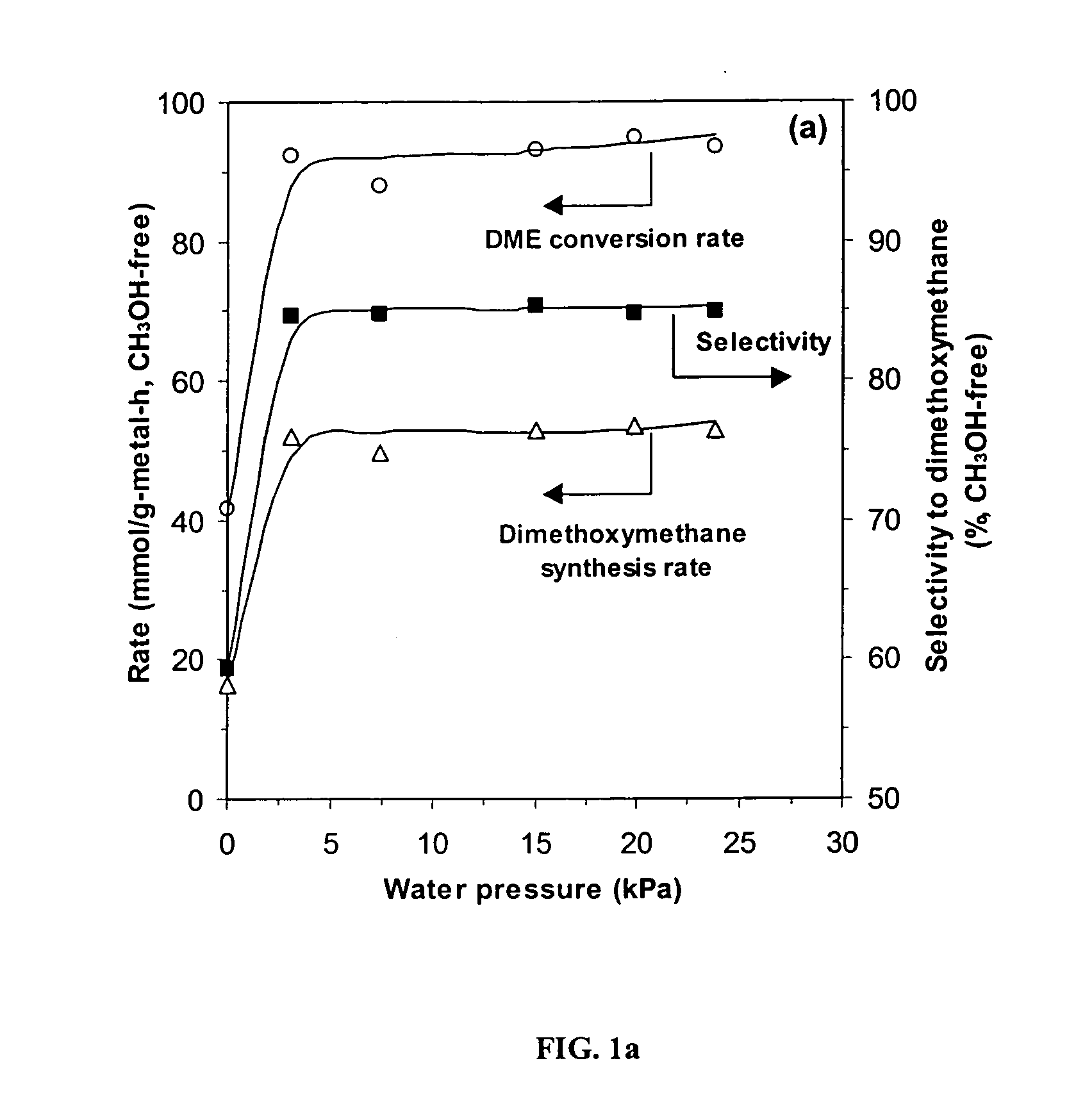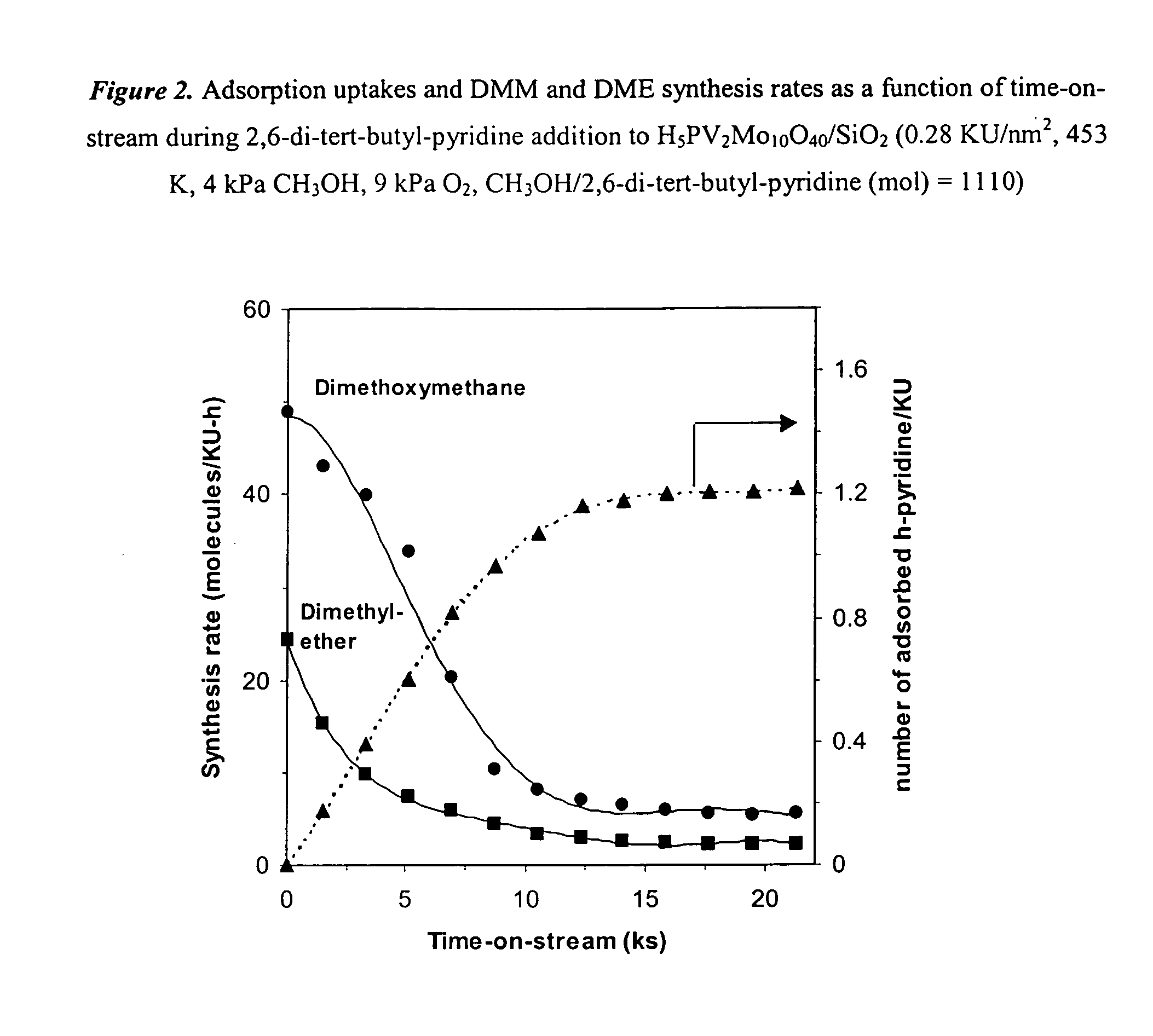Oxidation of methanol and/or dimethyl ether using supported molybdenum-containing heteropolyacid catalysts
a technology of molybdenum-containing heteropolyacid catalyst and methanol, which is applied in the direction of carbonyl compound preparation, carbonyl compound preparation, oxidation, etc., can solve the problems of only limited success, volatile rhenium oxide, and use of expensive materials as catalysts, so as to reduce the production of dimethyl ether
- Summary
- Abstract
- Description
- Claims
- Application Information
AI Technical Summary
Benefits of technology
Problems solved by technology
Method used
Image
Examples
example 1
Catalytic Oxidation of Dimethyl Ether on Unsupported or SiO2-Supported Catalysts
[0041] Table 1 shows dimethyl ether (DME) reaction rates and selectivities at 513 K, 80 kPa DME, and 20 kPa O2 on unsupported and SiO2-supported H3PMo12O40 and H5PV2Mo10O40 catalysts (treated for 1 h at 553 K). On the unsupported samples, dimethoxymethane (DMM) was the most abundant reaction product. Reaction rates were normalized per Keggin unit (DME molecules / KU-h) or per gram of V and Mo (mmol / g-metal-h). Reaction rates and selectivities were calculated by considering methanol as a product and as a result are reported on a methanol-free basis. At similar DME conversions (˜2%), reaction rates were about two times greater on H3PMo12O40 than on H5PV2Mo10O40, but the latter was more selective to desired partial oxidation products HCHO (14.8% vs. 2.8%) and DMM (56.8% vs. 46.0%), and formed less carbon oxides (COx) (14.9% vs. 24.5%). Methyl formate (MF) selectivities were much higher on H3PMo12O40 (16.7%) ...
example 2
Catalytic Oxidation of Methanol on Unsupported or SiO2-Supported Catalysts
[0044] Table 2 shows CH3OH conversion rates (DME-free) and selectivities obtained at 493 K on unsupported and SiO2-supported H3+nPVnMo12−nO40 (n=0,1,2,4) catalysts. These materials were treated in dry air for 1 h at 553 K. The effect of this thermal pretreatment in deactivating acid sites is described below. Reaction rates are reported normalized per Keggin unit (molecules / KU-h) and per gram of the active element (mmol / g-metal-h). Again, selectivities are reported both by considering DME as a product and also on a DME-free basis. The main products formed from CH3OH oxidation on H3+nPVnMo12—nO40 catalysts (n=0,1,2,4) were HCHO, dimethoxymethane, methyl formate, and DME. At these conditions, COx selectivities were very low (3OH conversions of nearly 70%. At similar CH3OH conversions, reaction rates on the unsupported heteropolyacids were only weakly influenced by the V / Mo content. DMM was the predominant produc...
example 3
Effects of Surface Density on Reaction Rate and Selectivity on H5PV2Mo10O40 / SiO2) Catalysts
[0048] Table 3 shows the effects of H5PV2Mo10O40 loading and surface density on the rate and selectivity of CH3OH oxidation reactions. Surface densities are reported as the number of Keggin units or the number of V and Mo active metal atoms per BET surface area (KU / nm2 and metal / nm2). For loadings less than 9.2 wt %, reaction rates remained nearly constant with loading. Higher surface densities led to a decrease in CH3OH reaction rates (per KU), perhaps because of incipient agglomeration of dispersed Keggin units into clusters with secondary crystalline structures. The samples with the lowest surface density (0.024 KU / nm2) gave very low DME selectivity (20.4%) and high HCHO selectivity. Increasing the surface density to 0.10 KU / nm2 led to higher DME and DMM selectivities and lower HCHO selectivities. At surface densities of 0.65 KU / nm2, DMM selectivities decreased and HCHO selectivities incre...
PUM
| Property | Measurement | Unit |
|---|---|---|
| temperature | aaaaa | aaaaa |
| temperature | aaaaa | aaaaa |
| temperature | aaaaa | aaaaa |
Abstract
Description
Claims
Application Information
 Login to View More
Login to View More - R&D
- Intellectual Property
- Life Sciences
- Materials
- Tech Scout
- Unparalleled Data Quality
- Higher Quality Content
- 60% Fewer Hallucinations
Browse by: Latest US Patents, China's latest patents, Technical Efficacy Thesaurus, Application Domain, Technology Topic, Popular Technical Reports.
© 2025 PatSnap. All rights reserved.Legal|Privacy policy|Modern Slavery Act Transparency Statement|Sitemap|About US| Contact US: help@patsnap.com



